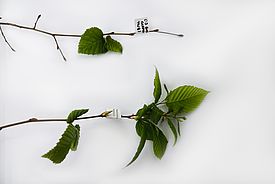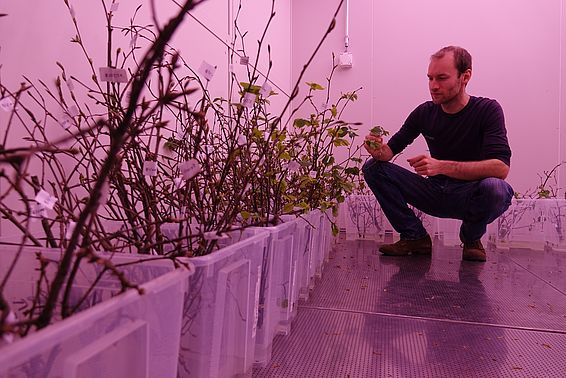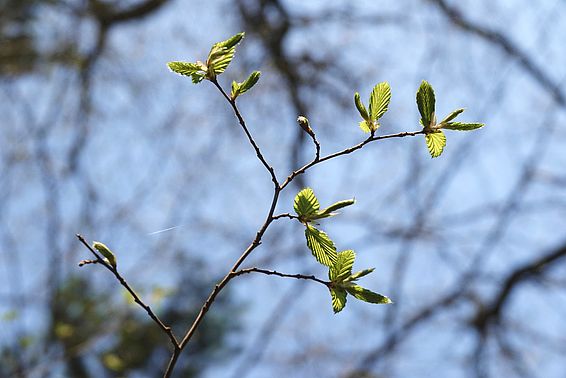19.03.2020 | Michèle Kaennel Dobbertin / University of Neuchâtel | News WSL
In gardens and hedges, the first leaves spread, and the flowers of fruit trees attract bees. In the forest too, the buds are about to burst. Spring is coming - but once again, the alarm clock has rung too early this year. Has this harmed forest trees? Researchers from the Federal Research Institute WSL and the University of Neuchâtel are studying the consequences of overly mild winter temperatures on vegetation.
The winter of 2019-2020 was the mildest ever recorded in Switzerland, with February in particular reaching record highs. MeteoSwiss stations measured several nights with temperatures that did not drop below 10 °C or even 12 °C, as well as days with values above 20 °C (for example 21.2 °C in Delémont in the canton Jura on February 16). Yet trees and shrubs in temperate climates need a certain amount of cold to ensure that the winter is over and to allow optimal growth, a process called chilling by scientists.
"When the buds have not been sufficiently exposed to the cold, the trees do not emergy properly from their winter rest, which specialists call dormancy. In the end, some buds don't even manage to develop normally," explains Frederik Baumgarten, a PhD student in biology at the Swiss Federal Institute for Forest, Snow and Landscape Research WSL.
In an ongoing experiment, the young researcher is experimentally quantifying the chilling requirement of trees. For this purpose, he placed more than 2000 twigs of six species common in Switzerland in climatic chambers and exposed them for several weeks to different winter conditions – more or less cold, for more or less time.
Some like it cold…

Initial results show that some species such as oak or birch need less cold than others to get out of their winter rest. Their spring development could therefore start earlier and earlier as the climate warms up. On the contrary, other species such as beech or maple need a fairly large amount of cold to ensure optimal development in the spring. "My analyzes show that certain temperatures, especially below 4 °C, are more effective in 'waking up' certain species, while for other species, all temperatures below 10 °C contribute equally in breaking dormancy“, comments Frederik Baumgarten.
Yann Vitasse, who supervises the thesis of the young biologist at the WSL, specifies: "For the moment, the amount of cold allowing to break the dormancy of the buds still seems sufficient in Switzerland for most of the trees in our forests, even after this winter. Very mild temperatures at the end of winter like this year's stimulate the onset of vegetation. This is especially the case for early species that need less cold to wake up, such as many fruit trees, but also hornbeams, birches and many shrubs. "For example, analyses of long data series carried out at the University of Neuchâtel and WSL show that apple and cherry blossoms are now about two weeks earlier than in the 1970s.
… but watch out for spring frosts
By starting earlier in response to global warming, vegetation may be more vulnerable to spring frost. This year, the risk is already high because of the mild weather in February, but the actual damage will ultimately depend on temperature fluctuations in March and April. "However, with the general rise in temperatures, the risk of frost has not significantly increased in the lowlands," says Professor Martine Rebetez, who recently directed two studies on this phenomenon. "On the other hand, it has increased slightly above 800 m."
In 2016 and 2017, severe freezing events occurred in April after already very mild periods. Especially the one in 2017 caused immense damage to orchards in Switzerland, Austria and Germany. “But our research has shown that this is an exceptional situation. In our latitudes, frost is a risk with which we have always had to deal. In fact, traditional sayings called for rain until the beginning of May, because a cloud cover avoids strong night-time cooling and therefore reduces the risk of frost," recalls Martine Rebetez.
News by University of Neuchâtel: http://unine.ch/unine/home/pour-les-medias/communiques-de-presse/hivers-trop-doux--quelles-conseq.html
Contact
Links
- Baumgarten, F., Zohner, C., Vitasse Y., 2019: Chilled to be forced: the best dose to awaken buds from winter dormancy. Geophysical Research Abstracts. Vol. 21, EGU2019-15862-1. (PDF)
- Vitasse, Y. & Rebetez, M., 2018: Unprecedented risk of spring frost damage in Switzerland and Germany in 2017. Climatic Change 149, 233-246.
Copyright
WSL und SLF stellen Bildmaterial zur Bebilderung von Presseartikeln im Zusammenhang mit dieser Medienmitteilung kostenfrei zur Verfügung. Eine Übernahme der Bilder in Bilddatenbanken und ein Verkauf der Bilder durch Dritte sind nicht gestattet.


